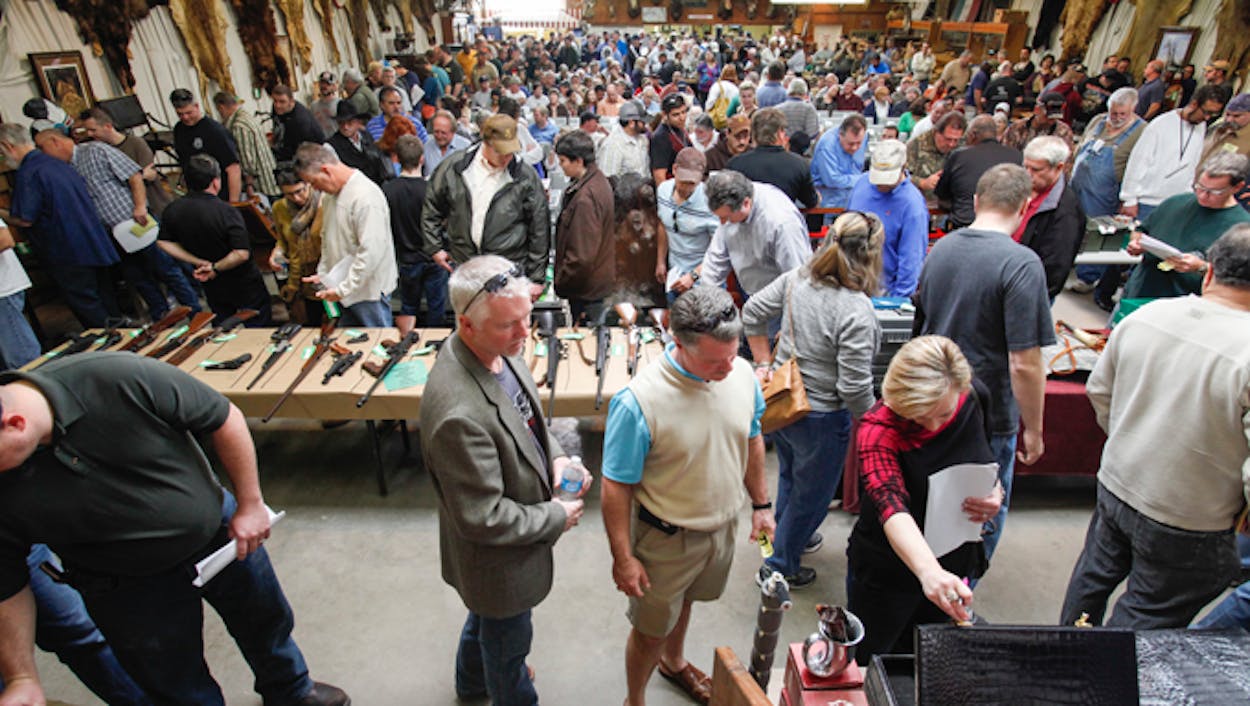Hundreds of Houstonians packed Webster’s Auction Palace this past Sunday to pick through the belongings of Michael Glyn Brown, the late, disgraced hand doctor whose years of erratic and violent behavior had made him one of the most infamous members of Houston society. The theme of Sunday’s bankruptcy auction, the third in Houston from Brown’s estate, was guns and taxidermy, and the room was bedecked accordingly. Moose and hyena skins were stretched along the walls. A gleaming white baboon skull sat on a table among aoudad horns and water buffalo skulls, souvenirs from his numerous African hunting safaris. Across the room prospective buyers ran their fingers over pieces of hippopotamus hide and an intact twelve-foot crocodile skin. Some were there for deals, others for a little sliver of notoriety. But most were there for the guns. A line of people—mostly middle-aged men—snaked out the door of the warehouse, waiting their turn to shuffle past butcher-paper-wrapped folding tables holding ninety of Brown’s guns, from a tiny Browning 6mm to a Chinese-made AK-47. “Look at that sea of people,” marveled one sheriff’s deputy working security at the auction.

Sunday’s auction came less than three months after the troubled hand surgeon was taken off life support at a Miami hospital. On October 24, police discovered Brown’s unconscious body in a closet at his $8.3 million island manse, previously owned by a Marlins shortstop. A suicide note sat on a nearby nightstand. He was 56.
Brown made millions through his patented technique to treat carpal tunnel and his string of surgical centers, the first of which he founded in Houston in 1988, six years after graduating from Baylor College of Medicine. But Brown’s promising medical career was undone by his love of drugs and alcohol, his penchant for domestic violence, and his tendency toward grandiosity and excess in all spheres.
The auction was so crowded in part because Brown had made a point of putting himself in the public eye during his lifetime. Most Houstonians remember his widely aired television commercial in which he says, “The Brown Hand Center will care for you, just as I care for my own family,” then he lifts his young daughter onto his lap and she exclaims, “Daddy’s baby girl!” Brown’s line would have been more convincing were it not for the stomach-churning string of headlines that he began garnering in 2001, when he was arrested for savagely beating his third wife with a broken bedpost at their home in The Woodlands when she was seven months pregnant. Brown accepted a deal requiring him to serve ten years of probation, avoiding jail time, and his wife was awarded $3.4 million and full custody of their two daughters in a civil trial. A year after that attack, his medical license was suspended temporarily for substance abuse and “unprofessional or dishonorable conduct.” (The Texas Medical Board revoked it permanently in 2006 after Brown tested positive for cocaine use.)
The former doctor managed to avoid the limelight for a few years, until a widely publicized trial in 2011, in which a jury ultimately found him not guilty of assaulting his fourth wife, Rachel Brown, who had accused him of throwing a humanitarian award at her, among other items. Brown soon relocated to Miami, where things began to unravel more quickly for him: in January 2012 a woman sued him for allegedly giving her herpes, and a year later he was arrested upon landing in Miami after attempting to choke a flight attendant on a British Airways flight from London. (Brown was found unconscious in his mansion a day before he was set to begin a thirty-day sentence in federal prison for that conviction.)
Brown’s incredibly convoluted bankruptcy case, filed initially in federal court in Miami last January but transferred to Texas’s Southern District in September, now has Chapter 11 and Chapter 7 components, the latter of which is likely to stretch on for years. The filings span hundreds of pages and are titled things such as “Order Requiring Rachel Brown to Surrender to Chapter 7 Trustee That One Certain 2009 Maserati GSS.” At court order, belongings from his residences in Texas, Florida, and New York are being sold off to raise funds to repay his debts. Sunday’s auction was just one small piece of that.
“This is not the end of Dr. Brown,” auctioneer Billy Webster remarked as he kicked off Sunday’s event, noting that several more sales of Brown’s belongings are planned, including one on January 26 of Brown’s clothing and furniture and a March 16 auction of his 237 writing pens. Wherever the line between collector and hoarder lies, Brown was certainly toeing it. 
The guns were taken from the eight-bedroom Memorial Drive home where Rachel still lives. The 6mm Browning, which, the auctioneer joked, “turns into a Desert Eagle when it grows up,” sold for $450, while the most expensive firearm, a commemorative Colt Army 45-caliber revolver with ivory grips, brought in $5,000. While the most fevered bidding was reserved for the guns, the more curious items on offer Sunday also found buyers. Someone shelled out more than $3,000 for a large wooden bear, carved from a tree from Brown’s Normangee ranch, Castlemane. Among its assets, according to Webster? “It doesn’t eat much.” (The 2,697-acre ranch itself, along with the exotic animals—including a herd of oryx, some zebras, and several ostriches—was sold for $8.5 million in November.) A pair of stingray work boots monogrammed with Brown’s initials fetched $200, with Webster suggesting that MGB could also stand for “mighty good boots.”) An antique barber chair sold for $650. A hyena hide brought in $450.
The scene that unfolded in the drab warehouse for six and a half hours that afternoon—a diamond-encrusted Rolex sold one minute, a dusty moose skin the next—was as frenzied and strange as Brown’s life itself. Even in death, he had created the same sort of lurid public spectacle that was his specialty.







